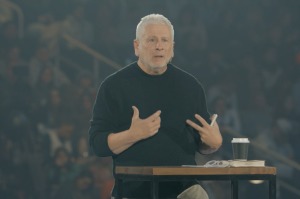Study: Americans Prefer In-Person Sermons Over Video Message Teaching
Most Americans prefer to attend a church where a pastor appears in person to preach rather than watching an Internet livestream or video of the sermon, despite the large number of multisite congregations that make practical use of the technological approach, according to a recent study by LifeWay Research.
The report revealed that 65 percent of Americans said they would choose a live, in-person sermon rather than a video teaching. Less than one percent said they would prefer video. The additional 30 percent surveyed reported that they had no preference and the remaining 5 percent said they didn't know.
"I don't think anyone gets up on a Sunday morning saying, 'Boy, I'd really like to watch a video sermon,'" said Scott McConnell, vice president of LifeWay Research, in an article at BaptistStandard.com. "But the fact that many churches utilize video sermons means other factors such as relationships, preaching approach, music, relevance and location can be more important."
The study was part of a telephone survey of 1,001 people conducted in September of last year. Researchers took into consideration region, age, gender, education level, church attendance as well as whether they identified as born-again, evangelical or fundamental Christians.
The findings also revealed that 37 percent of young adults are more likely to accept a video sermon than 24 percent of adults between the ages of 45 and 54. Furthermore, Americans in the Northeast part of the country are most open to a video sermon, with 40 percent saying they are fine with either option.
In addition, 41 percent of college educated respondents are more likely to prefer an in-person sermon as well as 37 percent of self-identified born-again, evangelical or fundamentalist Christians.
According to Jim Tomberlin of the consulting firm MultiSite Solutions, about half of nearly 5,000 multisite churches in the country use video teaching. In recent years, many megachurches that boast several campuses have embraced the use of high-definition video sermons, primarily as a way of adopting society's audio-visual preference but also because it allows pastors to not become burdened by physically preaching at various locations in the same day.
"Speaking personally, preaching on the weekend is the physical equivalent of running hard on a treadmill for 40 straight minutes, taking a 30 minute break and then getting back on again for another 40 minutes of hard running," says Pastor Matt Keller of Florida-based Next Level Church. "Having to do that 4 or 5 times in a 20 hour period of time over a weekend exacts a physical and emotional toll that takes more than just Sunday evening to recover from."
He added, "We knew that once our church added a fifth weekend service, it was paramount to the physical, emotional and spiritual well-being of myself and our speaking pastors that we not speak in-person in all of those services…We believe there is a better way to communicate messages at Next Level Church without our pastors paying such a high price. And we do that by leveraging technology and video teaching."
Much like Next Level Church, most multisite churches that embrace video teaching hold live prayer and worship experiences despite not having a live preacher. While this is the norm for large congregations like Elevation Church and LifeChurch.tv among thousands more, Tomberlin says smaller ones are not open to the idea.
"Small churches have a bias against video. As a church grows bigger, video gives them more options. It becomes a non-issue," said Tomberlin.
Ken Langley, president of the Evangelical Homiletics Society and pastor of Christ Community Church in Zion, Ill. says in-person preaching is an element of the worship experience that should be incorporated.
"I do think that there is something missing when the preacher is not present," said Langley, according to the Baptist Standard. "And it's hard to define. Presence is important."
However, Tomberlin says in-person preaching is not necessary because people can still connect with the message being preached much like people used to connect with Billy Graham's broadcasted crusade sermons while they watched from their homes, he says.
"God could still work, even if Graham wasn't in the room," said Tomberlin.





























